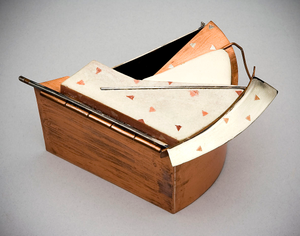unidentified Congolese
Description
Contact the Stanley Museum of Art at the University of Iowa: https://stanleymuseum.uiowa.edu/about/contact/ The Stanley Collection single object 2008 Storage Southern Savannah Kasai/ Sankuru Rivers Prestige Status Kuba 250,000 BaKuba, in the Central Bantu cluster of languages Central Zaire, at the confluence of the Sankuru and Kasai Rivers Chokwe, Luba, Luluwa, Lele In the 16th century, the Kuba peoples migrated from the distant north to their current location along the Sankuru River. When they arrived, however, they found that the Twa already lived there. The Twa were eventually absorbed into the Kuba Kingdom, but retained some independent cultural characteristics. The height of the Kingdom was during the mid 19th century. Europeans first reached the area in 1884, but the Kuba, being relatively isolated, were not as affected by the slave trade as many of the other peoples in the area. The Nsapo invaded during the late 19th century and the Kingdom was broken up to a large extent. The rivers which define the Kuba territory provide fish which is largely consumed in the area. They also farm maize and cassava, both of which were imported from the new world. The Kuba weave beautiful raffia cloth which is embroidered by the women and traded to surrounding areas. The Kuba Kingdom is actually comprised of numerous smaller ethnic groups, including the Bushoong, Ngeende, Kel, Pyaang, Bulaang, Bieeng, Ilebo, Idiing, Kaam, Ngoombe Kayuweeng, Shoowa, Bokila, Maluk, and Ngongo. The King of Kuba is always Bushoong. Each of the ethnic groups has a representative which...
Physical Object
Wood
University of Iowa. Stanley Museum of Art (host institution)
U.S. and international copyright laws protect this digital image. Commercial use or distribution of the image is not permitted without prior permission of the copyright holder. For permission to use the digital image, please complete an image request form http://www.lib.uiowa.edu/forms/uima or contact the University of Iowa Museum of Art.





















